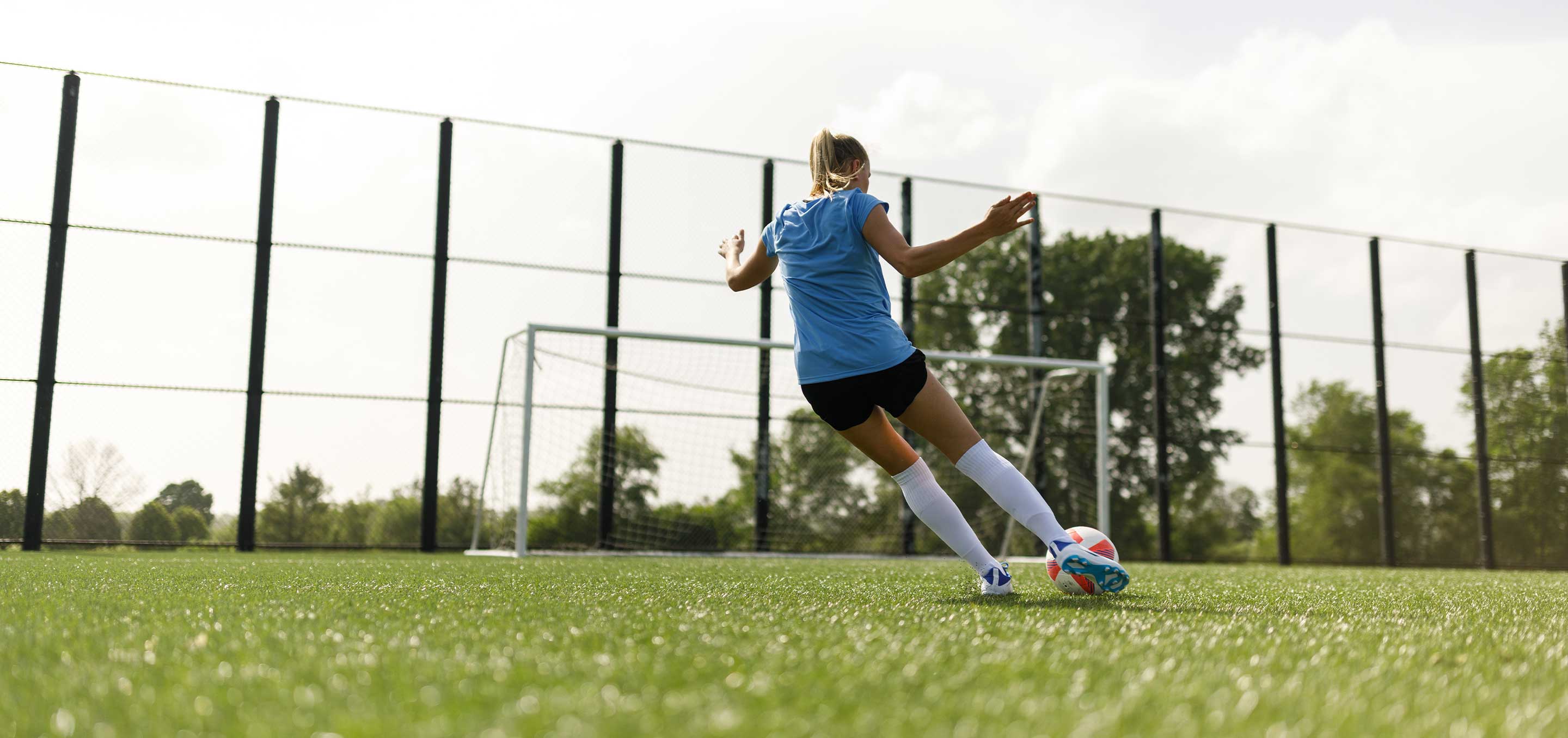How to Prevent The 5 Most Common Soccer Injuries

Prevent Common Soccer Injuries & Stay on the Field
What’s the true cost of an injury in soccer? It isn’t just the physical pain; it's the lost opportunities. The missed training sessions, the crucial games watched from the bench, the potential scholarships slipping away. Common injuries like tears, strains and sprains can derail your soccer journey. But what if you could minimize that risk?
Trusted by the pros, CURREX® CLEATPRO™ insoles for soccer cleats deliver the stability and support you need to avoid injuries and dominate the pitch. To keep you at the top of your game, let's explore the most common soccer injuries sidelining players and how you can avoid getting hurt.
The 5 Most Common Injuries for Soccer Players
The most common injuries in soccer are lower body injuries that affect the ankles, knees, and upper leg muscles like your hamstrings. They can range from simple strains, bruises and contusions to pain from overuse injuries caused by repetitive stress. For uninterrupted play, you need to understand these injuries and what causes them.

1. Ankle Sprains
Ankle sprains are the number one most common soccer injury. Symptoms include pain, swelling, bruising, and difficulty walking. Sprains usually happen during quick changes of direction like pivoting or when playing on uneven fields, causing the ankle to twist, bend, or land awkwardly.
CURREX CLEATPRO insoles can help prevent ankle sprains in soccer thanks to the decoupled heel cup that stabilizes the foot and heel to limit unwanted movement.
2. Muscle Strains
Muscle strains happen when a muscle or tendon stretches too far, causing a partial tear. Also called a pulled muscle, soccer players are more prone to upper leg, groin, and calf strains. Typical symptoms include pain, swelling, muscle weakness, and limited mobility.
Along with warming up before a game, make sure your soccer cleats are the right fit. With the right support, a good fitting cleat may help prevent strains by evenly distributing pressure, cushioning impacts, and allowing for natural movement.
3. Knee Injuries
Twisting, cutting, and other rapid movements can strain or tear ligaments and other tissues in your knee. An ACL tear, for example, often happens while pivoting. However, an MCL sprain in soccer can happen after colliding with another player or when you squat and twist.
Soccer knee injuries can be extremely painful, putting a quick end to the season. One way to protect against knee pain in soccer is to absorb the impact at the feet with good cleats that have targeted cushioning and arch support.
4. Overuse Injuries
Overuse injuries are caused by repetitive impact or stress to muscles, joints, and connective tissues resulting in inflammation and pain. In soccer, these include:
- Shin splints
- Achilles tendinitis
- Plantar fasciitis
- Iliotibial (IT) band syndrome
- Runner's knee
- Stress fractures
Having flat feet or extremely rigid arches increases your risk for many of these. CURREX CLEATPRO insoles help you avoid injuries like shin splints in soccer with customized support for all arch types plus targeted cushioning to absorb impact and reduce stress.
5. Concussions
Head injuries are another common soccer injury usually caused by contact with another player or equipment such as a goal post. Despite popular belief, heading the soccer ball does not cause concussions as long as it’s done properly.
Symptoms of a concussion in soccer include headache, nausea, dizziness, balance problems, blurry vision, and sensitivity to light or sounds. After a head injury, always follow concussion protocols. Stop playing immediately and talk to a healthcare provider.
How CURREX Soccer Insoles Reduce Injury Risk
Every cut, shoot, kick and turn starts with your feet. Having a stable foundation that supports your movement and redirects impact is key to injury-free play. CURREX CLEATPRO soccer insoles optimize your movement and return stored energy, minimizing strain and fatigue so you can get injured less and play more.

Unlike other sports insoles, CLEATPRO insoles were developed to meet the unique demands of soccer with the following features:
- Dynamic Arch Technology fully engages the foot to increase sensory stimulation, reduce strain on the lower body, and protect against damaging peaks of force.
- Highly Customized Support caters to your foot’s structure to distribute pressure evenly and reduce unwanted movement.
- Deep, Decoupled Heel locks in the perfect fit in cleats for optimal heel stability.
- Targeted Cushioning absorbs shock in the heel and forefoot, returning energy to reduce the overall impact on your lower body.
- No-Slip Grip provides full foot-to-cleat contact for zero slipping and complete ball control.
CURREX CLEATPRO insoles prevent soccer injuries like shin splints, ankle sprains and knee pain by optimizing foot biomechanics for reduced pressure, fatigue, and enhanced comfort and control.
Learn more about how CURREX Sports Insoles Prevent Injury & Reduce Fatigue.

Why do I keep getting injured in soccer?
Soccer is a close-contact game with quick starts, stops, and pivots that can lead to injury. Most soccer sports injuries happen because of poor conditioning, overuse, and bad technique. Worn cleats, collisions with other players, and failure to recover after an initial injury also play a role.
Whether it's a new injury or a recurring issue like ankle sprains, addressing imbalances in your strength and flexibility can help you avoid future injury.
What soccer position is most likely to get injured?
A 2018 study in the Orthopedic Journal of Sports Medicine analyzed soccer injuries that happened during the 2017 Gold Cup. The study found no significant differences in injury frequency between soccer positions; however, forwards experienced the most injuries among themselves, making them more likely to get injured.
How to Prevent Getting Injured in Soccer
With the right preparation and sport-specific exercises, you can significantly reduce your chances of getting hurt on the field. Improving imbalances in your muscles and technique will help you both feel and perform better. Here are our best tips for preventing most soccer injuries:
- Warm up for 15-20 minutes. Always warm up before a game or practice by running laps and stretching the lower body. This keeps the muscles flexible and less prone to injury.
- Stay hydrated. Drinking enough fluids and replenishing electrolytes before, during and after a game is crucial to preventing injuries caused by fatigue.
- Wear protective gear. Lower leg injuries are more common in players who don’t wear shin guards as they protect against abrasions and impact.
- Wear the right cleats. Soccer cleats must fit well and have proper traction for playing conditions.
- Use soccer cleat insoles. CURREX sports insoles are designed to prevent injuries by reducing stress on the lower body and improving comfort and stability.
- Check playing conditions. Avoid playing in inclement weather and check to make sure the fields are even. Equipment like goal posts should be well padded and properly secured.
- Stay fit in the off-season. Cross training is a great way to stay well-conditioned and improve any muscle imbalances, especially if you play seasonally.
If your child plays youth soccer, limiting how often they play throughout the year can help prevent injuries like Sever’s disease or heel pain. For example, if your kid is part of a year-round youth soccer club, they might not play for their school in the fall.

When to Return to Play
As a rule of thumb, you should only return to play post-injury when:
- All symptoms are gone, including no more pain or swelling.
- You have normal strength and a full range of motion.
- You’ve been cleared by a healthcare provider and passed necessary testing.
When injured, the most important thing you can do is give yourself plenty of time to heal. Rushing back onto the field when your body isn’t ready increases your risk of re-injury, which can be far more serious than the initial injury. Seeing a physical therapist is one way to help speed up your recovery.
Stay on the Pitch with CURREX CLEATPRO
Soccer injuries can sideline even the most dedicated players. From ankle sprains and strains to knee injuries and overuse issues, the risks are real. For game-changing support that protects against injuries, try CURREX CLEATPRO insoles for soccer cleats.

CURREX does not diagnose or treat medical conditions or injuries. CURREX insoles are designed to help reduce the risk of injury by supporting athletes' movement, improving comfort, and reducing lower body strain.
References:
Alaia, M. (2023). Soccer Injury Prevention. Aaos.org.
Chahla, J., et all. (2018). Epidemiological Findings of Soccer Injuries During the 2017 Gold Cup. Orthopaedic Journal of Sports Medicine, 6(8), 232596711879175. https://doi.org/10.1177/2325967118791754







